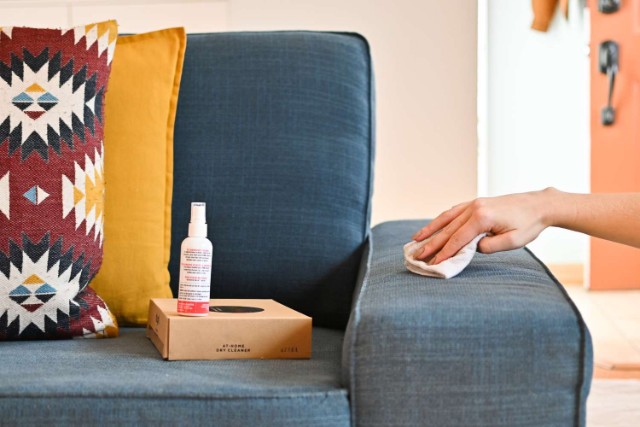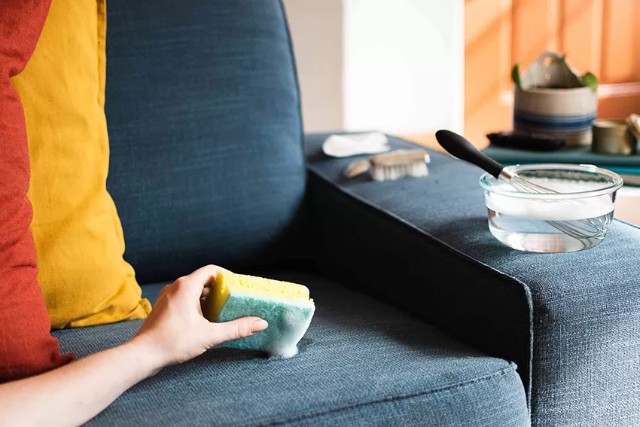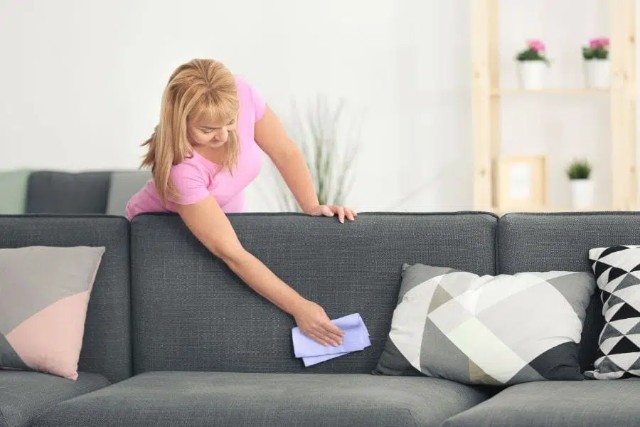As a homeowner, I know how important it is to keep your furniture clean and looking its best. Fabric sofas can be notoriously difficult to clean, but with the right supplies and a little bit of elbow-grease, you can get them looking fresh and new again.
One of my favorite cleaning approaches for fabric sofas is vinegar. It’s an all-natural solution that won’t damage the fabric, yet it still gets the job done.
In this Nousdecor article, I’ll walk you through step-by-step instructions on How To Clean Fabric Sofa with vinegar – from gathering supplies to removing any excess stains.
Let’s get started with our guide on effective sofa cleaning tips!
Key Takeaways of How To Clean Fabric Sofa
- Vinegar is a natural and effective solution for cleaning fabric sofas without damaging the fabric.
- Vacuuming the sofa thoroughly before cleaning helps remove dirt and dust from deep within the fibers.
- Mixing 1 part white vinegar with 2 parts warm water-based cleaner creates a gentle cleaning approach.
- Testing any cleaning product on an inconspicuous area of the sofa helps prevent discoloration or damage to the fabric.

Cleaning Codes: Gather Supplies To Clean a Fabric Couch
Gather your supplies and get ready to make your Best Sofa look as good as new! For this job, you will need a vacuum cleaner, a soft-bristled brush, a clean cloth or sponge, and some white vinegar.
If the couch is visibly dirty in some spots, you may also want to have an old toothbrush handy. Make sure that you have everything you need before starting so that you don’t have to run around looking for them.
Now it’s time to start cleaning. Begin by vacuuming the furniture thoroughly with the upholstery attachment. This will remove any dirt and dust from deep within the fibers of your couch.
Focus on areas where dirt may accumulate such as crevices between cushions and along seams or folds in fabric. Then use the soft-bristled brush to gently loosen any stubborn particles stuck in fabric fibers. Be sure not to rub too hard though – this could damage the material over time!
Next comes the vinegar solution: mix one part white vinegar with two parts warm water in a spray bottle and lightly mist your sofa with it until dampened but not soaked through. Allow it to sit for several minutes before wiping down with a damp cloth or sponge in circular motions until all visible stains are removed from the surface of your couch fabric.
The acidity of the vinegar helps break down grease and dirt so that they can be more easily lifted away without harsh scrubbing or chemical cleaners which can cause discoloration or fading over time.
Finally, let the couch air dry completely before using it again – no one wants soggy furniture! With these simple steps, you’ll have your beloved couch looking brand new again without spending too much money on expensive store-bought cleaners or taking it into an upholsterer for repair work.
Now that everything is taken care of, go ahead and move on to vacuuming the sofa for best results!
Step 1: Clean Upholstery Vacuum the Sofa
Before you start tackling any messes, give your fabric sofa a thorough vacuuming to remove dirt and other debris. Use the upholstery attachment on your vacuum cleaner, if available, to ensure that all dust and crumbs are removed from crevices and seams.
To pick up pet hair or lint, use a lint roller or damp cloth. Make sure to move cushions out of the way so they don’t get forgotten in vacuuming process (see sofa cushions cleaning guide for more cushion info). Use the vacuum cleaner underneath them as well. Pay special attention to areas around arms and back of furniture where dust accumulates quickly due to air movement.
This step is important because it reduces the amount of soap needed for cleaning later on and makes it easier for you to spot stains more easily. Once done with vacuuming your couch, check for any remaining visible dirt or debris before moving on the next step: creating a cleaning approach.
Step 2: Create a Cleaning Solution For Deep Cleaning a Couch
Mix a few drops of mild detergent with warm water to make a cleaning approach that is gentle enough for your fabric futon seat.
Be sure to use only a small amount of detergent, as too much can damage the fabric and leave it feeling stiff or sticky. It’s best to mix the solution in an inconspicuous spot on your couch first to ensure it does not cause any discoloration or staining.
If you choose to add vinegar, start by adding 1/4 cup of white vinegar per gallon of warm water for light cleaning and 1/2 cup for deeper cleaning, stirring until fully combined. Adding essential oils such as lavender or lemon can help give the room a pleasant smell after you’re done cleaning.
When creating this mixture, be sure to wear rubber gloves and work in a well-ventilated area since the smell of vinegar can be strong. Once completed, you are ready to test the cleaning approach on your fabric futon seat!

Step 3: Test the Cleaning Solution Before Cleaning a Fabric Sofa
Take a moment to ensure your cleaning approach is ready for testing on your beloved furniture before proceeding. You can do this by:
- Examining the mixture: Make sure it smells good and looks clean; Ensure that all ingredients are properly mixed together.
- Testing the solution on a small piece of fabric: Select an inconspicuous area of the couch and dab some of the solutions onto it, using a cotton ball or cloth; Wait a few minutes for it to dry so you can check if there’s any discoloration.
- Observing how long it takes to dry: If it dries too quickly, add more water; if too slowly, reduce water levels in the mixture.
Now that you’ve tested your vinegar-based cleaning approach, you’re ready to apply it safely onto your fabric futon seat without worrying about causing any damage or discoloration!
Step 4: Apply the Cleaning Solution Onto the Leather Couch Cushion
Now it’s time to apply your carefully crafted cleaning approach and make your beloved furniture look good as new!
Start by placing a towel or cloth on the surface of the couch, then spray the solution liberally onto the fabric. Work in small sections and use a soft-bristled brush or sponge to lightly scrub around any trouble areas.
Make sure to cover every inch of fabric with the solution. Once you have finished with one section, move on to another and repeat until you have covered the entire couch. Do not over-saturate any area, as too much liquid can damage upholstery fabrics (see clean sofa upholstery at home for more upholstery guide).
Be careful when spraying near seams and cushion edges so that no excess moisture leaks down into their cores; this can cause mildew growth later on.
Additionally, be mindful that some fabrics may become discolored if exposed to vinegar for too long. To prevent this from happening, use less solution in those areas or don’t allow it to sit for more than 10 minutes before wiping away.
When you’re done applying the cleaning methods, wipe off any remaining residue with a dry cloth before moving on to drying your futon seat thoroughly.
Step 5: Dry the Microfiber Couch Fabric
Once you’re done applying the solution, it’s time to dry your beloved furniture – grab a clean cloth and start wiping away!
Wipe off any excess cleaning mess with the damp cloth in circular motions. This will help absorb any remaining moisture and prevent it from seeping into the fabric. Once you’ve wiped away all of the excess liquid, take another dry cloth and slowly dab at the couch until all of the moisture is gone.
If you feel that there are still some wet spots, use a hairdryer on its lowest setting to speed up the drying process. Make sure to keep it moving so that only one spot doesn’t get overheated.
After drying, inspect your furniture for any excess stains or dirt that wasn’t removed by the vinegar solution. If there are any stubborn stains, try using a soft bristled brush to gently scrub at them until they come out – make sure not to use too much pressure though as this can damage your couch’s fabric!
Once you’ve finished removing all of the stubborn stains, give your couch one last wipe down with a damp cloth and then let it air-dry completely before using it or putting covers on it again.
Moving onto removing any excess stains…

Step 6: Final Couch Cleaning Instructions on Removing Stains
Using a soft cloth, gently dab at any stubborn stains that are still present to help lift them away from the surface.
Make sure not to rub too hard as this can damage the fabric. In order to get rid of more difficult stains, mix one part white vinegar with two parts warm water and apply it on the stain. Let it sit for 5-10 minutes before lightly scrubbing the area with a soft brush or sponge.
| Solution | Method | Time |
| White Vinegar & Water | Apply and scrub | 5 – 10 min |
| Soft Cloth | Gently dab | 3 – 5 min |
| Soft Brush/Sponge | Lightly scrub | Depends |
Be sure to keep testing any solutions in an inconspicuous area first in order to prevent discoloring or damaging your couch fabric. Once you’ve finished cleaning, use a clean towel or cloth to dry off the area completely.
Doing so will help stop more dirt from being absorbed by the fibers and causing further staining. This should help your couch look like new again!
Frequently Asked Questions
Conclusion
I’m always pleased with the results of cleaning my fabric sofa with vinegar. It’s a great way to remove dirt and grime, leaving the fabric looking like new.
I make sure to vacuum the couch first, then test my cleaning approach before applying it. After drying, any remaining stains can be removed easily by lightly scrubbing them away.
With these steps, I’m left with a clean, refreshed sofa that looks as good as new! If your couch is a suede, check out our article on clean suede sofa effectively for a better guide!

![How To Clean A Couch? In-Depth Guide [2024]](https://nousdecor.com/wp-content/uploads/2021/06/How-To-Clean-A-Couch-300x222.jpg)
![How To Place A Rug Under A Sectional Sofa? [2024]](https://nousdecor.com/wp-content/uploads/2021/06/how-to-place-a-rug-under-a-sectional-sofa-to-balance-your-room-decor-300x169.webp)

![Tips To Make An Old Sofa Look Like New [2024]](https://nousdecor.com/wp-content/uploads/2021/06/Tips-To-Make-An-Old-Sofa-Look-Like-New-300x225.jpg)

